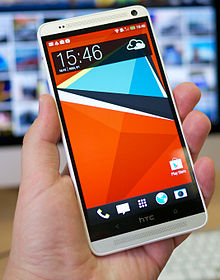 | |
| Manufacturer | HTC |
|---|---|
| Type | Smartphone ("phablet") |
| Series | HTC One |
| First released | October 2013 |
| Related | HTC One HTC One Mini |
| Form factor | Slate |
| Dimensions | 164.5 mm (6.48 in) H 82.5 mm (3.25 in) W 10.29 mm (0.405 in) D |
| Weight | 217 g (7.7 oz) |
| Operating system | Android 4.4.2 KitKat with Sense 6.0 |
| System-on-chip | Qualcomm Snapdragon 600 APQ8064 |
| CPU | 1.7 GHz quad-core Krait 300 |
| GPU | Adreno 320 |
| Memory | 2 GB RAM |
| Storage | 16 or 32 GB |
| Removable storage | up to 64 GB |
| Battery | 3,300 mAh Li-Po |
| Rear camera | 4-megapixel, 2688 x 1520 pixels, 2.0 μm camera with auto focus, UltraPixel BSI 1/3" image sensor, smart LED flash, F2.0 aperture, 28 mm lens, dedicated imaging chip, digital image stabilization, continuous shooting 1080p@30fps video recording, 720p@60fps video recording, video stabilization, slow motion video capture (768 × 432 pixels), HDR video recording |
| Front camera | 2.1-megapixel front camera (1080p@30fps for recording and video chat), HDR video recording |
| Display | 5.9 in (150 mm) Super LCD 3 with RGB matrix 1920×1080p pixels 16:9 Aspect ratio) (367 ppi) Corning Gorilla Glass 3.0 |
| Connectivity | Wi-Fi: 802.11 a/ac/b/g/n (2.4/5 GHz) GPS & GLONASS Bluetooth 4.0 with apt-X DLNA Wi-Fi Direct Miracast Wi-Fi Hotspot USB 2.0 (Micro-B Port, USB charging) 3.5 mm (0.14 in) TRRS |
| Codename | T6 |
| Other | Accelerometer, gyroscope, digital compass, proximity sensor, ambient light sensor, fingerprint scanner |
| References | [1][2] |
Preview warning: Page using Template:Infobox mobile phone with unknown parameter "media_formats"
The HTC One Max is an Android phablet smartphone designed and manufactured by HTC. The device is a larger variant of HTC's 2013 flagship high-end smartphone, the HTC One, notably incorporating a 5.9-inch display and fingerprint recognition features.
The release of the One Max was met with mixed critical reception; although the software updates introduced in Sense 5.5 were noted as positive improvements, the One Max was panned for using the same hardware as the One and for the operation of its fingerprint sensor.
- ^ "HTC One Max - Full phone specifications". GSMArena.com. Archived from the original on 23 September 2017. Retrieved 14 October 2013.
- ^ "HTC One max specs". PhoneArena.com. Archived from the original on 2017-06-17. Retrieved 2013-10-14.